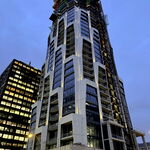I see the logic, but unless youre extending that line up Mount Pleasant to Eglinton, it acts soley as a reliever line for B-D. Putting it along Sherbourne or Parliament allows it to act as both a reliever for B-D, and be a catalyst for development on the east side of downtown.
However, if it were to be extended north to Eglinton, it would act in essence as a Yonge Express, which would hold some weight.
However, if it were to be extended north to Eglinton, it would act in essence as a Yonge Express, which would hold some weight.




